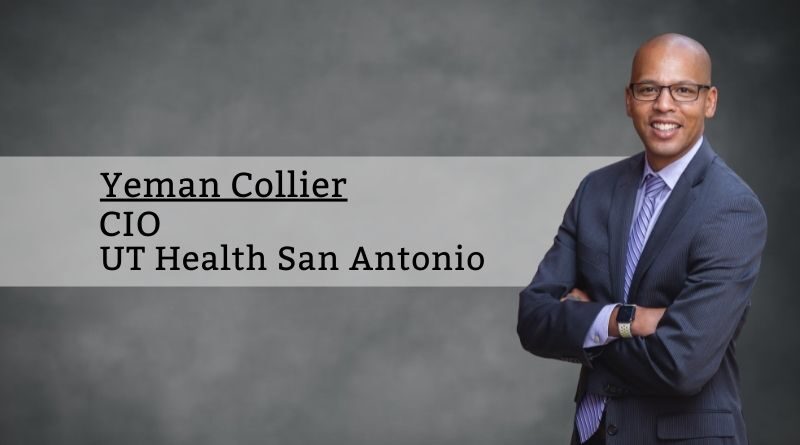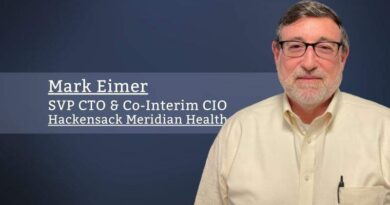Pandemic Triggered Technology Innovation in the Healthcare
By Yeman Collier, CIO, UT Health San Antonio
In terms of sickness and loss of life, the events of the last 18 months related to the COVID-19 pandemic have been altogether unprecedented in modern times. Even as the pandemic ravages communities across the nation and around the world, silver linings have emerged in terms of innovation enabling the provision of healthcare. The rapid adoption of various information technologies in response to the pandemic and their effective use by both healthcare practitioners and the underlying operations engines are testament to our ability to adapt.
Regulatory Reckoning
There were several major catalysts to patients, the broader healthcare community, and caregivers embracing novel methods of receiving and providing care during a pandemic, not the least of which was the expansion and acceptance of telehealth, virtual check-in, and e-visits under the 1135 Waiver. The waiver created a pathway for providers to administer and bill for a broader range of clinical services than had been possible in the past. Even with communities in lockdown and many hospitals and clinics severely curtailing elective procedures, patients still require consultation with their providers. Fortunately, the increasing comfort of both patient and provider with this modality of care evolved virtually overnight as COVID gripped the nation in ways never before witnessed.
Mental Health and Addiction Recovery
A key area of opportunity relates to virtual mental health consults, advising patients with a substance use disorder, and timely availability to pediatric psychiatric care. Remote patient monitoring enabled through an application on a smartphone, can send reminders to a recovering patient to collect a blood-alcohol reading through a wireless handheld breathalyzer. FDA-approved precision digital therapeutics are emerging as powerful tools in transforming specific behaviors. Managing depression via periodic inquiries to quantitatively measure mood scores and tracking trends over time can be critical to recovery and avoiding regression. Finally, through immediate 24/7 access via virtual visits, parents, caregivers, and counselors have rapid access to pediatric psychiatric specialists during an agitation event.
Security Confidentiality and Compliance
Several aspects that now require greater scrutiny in this emerging virtual health domain involve security, confidentiality, and HIPAA compliance. The nuance associated with patient and/or caregiver consent, appropriate access to electronic patient data, and de-identification or anonymizing of aggregate data collected via wearable devices for population health research must be prioritized and reconciled. Also, secure billing and collections, valid prescription refill requests, and having both technology and process protocols in place must help in minimizing fraud.
Extending Critical Care to Rural Communities
While Texas is home to 3 of the top 10 largest cities in the country, there are broad swaths of the state that remain very rural with limited local access to quality care. Many of these hospitals do not have continuous access to intensivists, but virtual ICUs has changed this landscape with the present ability for a remote clinician to now not only review documentation of a critically ill patient’s record but also monitor any number of clinical diagnostics in real-time support of bedside care teams. Also, video consultation allows even deeper, more meaningful interaction and collaboration with these local care teams.
There’s no better time to refocus on how we as healthcare leaders can serve as advocates and offer solutions to these emerging realities.
Refocusing on Healthcare Disparities
The increase in telemedicine adoption has also illuminated very real healthcare disparities, inequitable access to quality care, and helped clarify this notion of a “digital divide” within various demographic and socioeconomic cohorts. Lack of broadband internet access severely limits or makes impossible, meaningful virtual interactions between patient and provider, remote monitoring of the chronically ill through wearable devices, and real-time mental health or addiction management assessments. Increased use of technology within the provision of care carries with it a real possibility of marginalizing communities of color, elderly populations, those who are less technology-savvy, and populations who cannot afford high-performance data plans. There’s no better time to refocus on how we as healthcare leaders can serve as advocates and offer solutions to these emerging realities.
The Emerging Virtual Workforce
Even as labor shortages have tightened the availability of skilled nurses in the last 18 months, an emerging reality has firmly established among many faculty and administrative functions within the healthcare sector: the virtual workforce is both effective and sustainable. The immediate response by healthcare administrators to the rapid spread of the pandemic was to move large business-critical back-office functions like Finance, IT, and HR to virtual worker models. Within academic medical centers across the country, teaching environments that were traditional in-person didactic instruction got transitioned to 100% virtual almost overnight. As organizations adapted to these remote or hybrid work arrangements largely without significant negative impact on operations, the acknowledgment that virtual workforces can be successful came into focus. Remote and hybrid worker models are here to stay.
Conclusion
One reality the pandemic has reinforced is that crisis can quite effectively drive process, operations, and applied technology innovation. Virus or not, our missions of providing healthcare and driving clinical research discovery while also educating the next generation of providers and researchers remains unchanged. Information Technology will continue to prove instrumental in meeting our respective communities and their needs where they are. If necessity is indeed the mother of invention, then perhaps pandemics, even with all of the human tragedy they impart, can serve as catalysts to healthcare modernization in a meaningful and lasting way.



